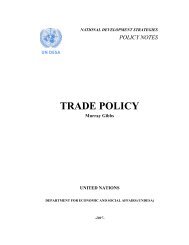Best Policy Practices
Best Policy Practices
Best Policy Practices
You also want an ePaper? Increase the reach of your titles
YUMPU automatically turns print PDFs into web optimized ePapers that Google loves.
<strong>Best</strong> <strong>Policy</strong> <strong>Practices</strong><br />
SF GreenPRINT<br />
United States<br />
A scorecard as a tool to monitor,<br />
measure and compare environmental<br />
and economic impacts.<br />
Making the impacts of our buildings real to the public and<br />
decision makers is critical to advancing green building. Equally<br />
important is the need to compare the environmental and<br />
economic results achieved through various green building<br />
practices and technologies. The resulting information can<br />
drive decisions today as well as the research priorities for<br />
the future. Wouldn’t it be nice to have a simple scorecard<br />
that could explain, with real numbers, the environmental and<br />
economic impacts of green buildings? Yes, and it has become<br />
a reality through the SF Green Project Reporting and Information<br />
Tool www.sfgreenprint.org.<br />
SF GreenPRINT quantifies individual building-level<br />
environmental and economic impact information that can also<br />
be aggregated across agencies or entire sectors, such as the<br />
Federal government, local government, or a university system.<br />
The web-based application tracks and reports on the environmental<br />
benefits and economic savings that accrue to a building<br />
owner throughout all phases of the design and construction<br />
of green building projects using the LEED Green Building<br />
Rating System. Developed by the San Francisco Department<br />
of the Environment under a grant from the US Environmental<br />
Protection Agency (EPA), it was designed to be adapted to<br />
incorporate other organizations’ local environmental and economic<br />
metrics and unique requirements.<br />
SFGreenPRINT:<br />
• Monitors the progress of projects and LEED for New<br />
Construction and Major Renovations, Existing Buildings,<br />
and Commercial Interiors (LEED-NC, LEED-EB, and<br />
LEED-CI) credits for which they are applying.<br />
• Evaluates green building projects based on calculated<br />
environmental and financial savings based on achieving<br />
specific LEED credits.<br />
• Incorporates adjustable settings to reflect local avoided<br />
emissions, energy and water rates, tipping fees, and other<br />
data that vary across the nation.<br />
67
















